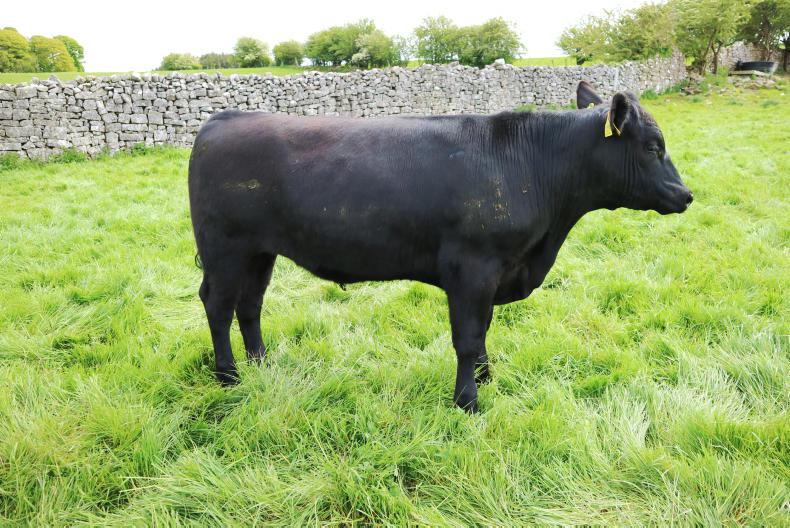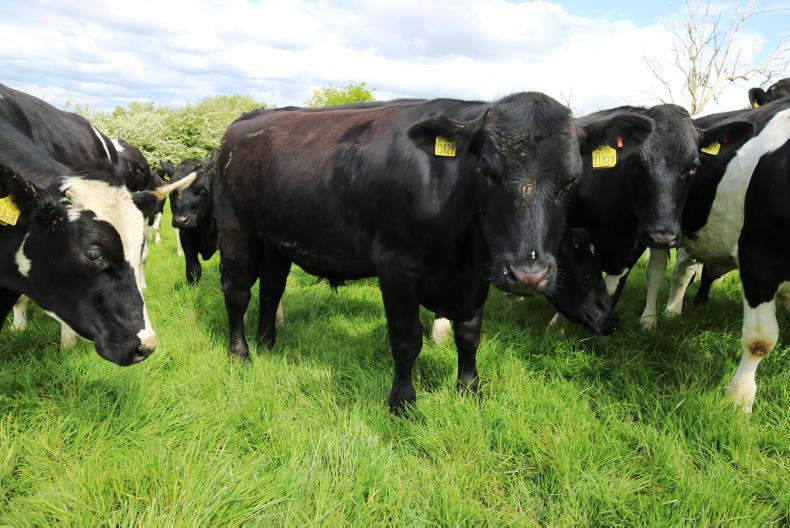The majority of the farmers involved in the Thrive dairy calf to beef programme are beef farmers. However, there are many dairy farmers out there who will bring through their own progeny to beef. One such farmer is Diarmuid Murray, who farms with his father Sean and his uncle Seamus at Knockcroghery, Co Roscommon.
Together they milk 110 cows and will also bring all progeny on the farm through to beef. The breeding programme consists of 100% AI, with the first 70 to 80 cows being served to dairy bulls. Beef sires will also be selectively used on cows that are not suitable to breed replacements. The remainder of the herd, which consists of 30 to 40 cows, will be served with beef sires, which are predominantly Angus. Diarmuid carries out all the AI on the farm himself. Cow type is a Holstein British Friesian cross.
Finishing
The land base is fragmented, with approximately 60ac in a block that is used for silage production and for the beef stock.
“We would try and get heifers away at 17 to 19 months and bullocks away under 20 months too,” Diarmuid explained.
“We are limited when it comes to winter housing so we can’t afford to house stock for a second winter. The land is fragmented so we are limited with what we can do with it. That is why we keep all stock through to beef.”
Over the past few years, Diarmuid has put an increased focus on the breeding of the herd and through the programme he hopes to be able to improve the quality of the beef progeny that he is producing.

AA2301 yearling heifer.
“I suppose one of the main reasons we wanted to be involved with the programme is that we want to look at the key performance indicators and see what we are doing well and what we can improve on.”
Diarmuid continued: “We want to improve our grassland management and we see the weighing as being vital when it comes to making breeding decisions on the farm.
“A lot of farms milk-record and think nothing of it. We see weighing as being something similar – you have the figures in front of you then and can make an informed decision on what is performing and what is not.”
The hope is that by using the bulls outlined in the programme that the farm will be able to increase the value of the beef progeny.
“We hope that by using more efficient bulls that we will have better calves and better stock for finishing but at the same time we can’t afford to have cows suffering. We still have to target the easy-calving sires.
“Carcases would generally average 290kg to 300kg for the steers but it can be a real difficulty when it comes to grading. Heifers could go at anything between 230kg to 270kg,” Diarmuid said.
“It is difficult to get the dairy-cross animal to grade well. It would be mainly Os and not too many Rs.”

AA2301 yearling heifer.
While Diarmuid doesn’t have to worry about selling his own calves, he admits it is something that more and more dairy farmers are looking at. “Farmers have to make sure that there is a market for their calves and that a farmer is willing to buy the type of calf that they are producing. The calf still needs to make a viable income for someone; the system has to be sustainable or we will have real issues.”
In previous years, the farm has used Angus bulls such as AA2301, JZJ, ZLT and AA2259. This is where it pays to take a deeper look at the dairy beef index and why it should be used as a tool when it comes to selecting sires to use.
ZLT has a dairy beef index of €71. This is made up of €40 from the calving value and €31 from the beef value. Looking deeper, gestation length for this bull is -2.31 days while calving difficulty is 2%, both ideal figures for a dairy farmer trying to get live calves on the ground. However, if we look at the carcase figure it is -3kg, while the percentage of progeny that do not meet specification is 21%. These are not traits that beef farmers would be targeting.

JZJ yearling steer.
If we compare this to another bull that has been used on the farm, AA2301, we find he has a DBI of €89. Breaking this down, the calving value is €39 while the beef value is worth €50. This bull’s gestation length is still -0.78 with a calving difficulty of 0.8%. However, the real advantage is that this bull has a carcase value of +11kg with the percentage of carcases out of specification at 14%.
Between these two bulls there is a 14kg difference in carcase weight. If we were to take this at a price of €4/kg it would mean a difference of €56 in value of the carcase to the finisher. On top of this, there is a 7% drop in the number of progeny that would also be out of specification.
While the DBI is a good tool to use when it comes to picking bulls, it pays to look deeper than just the overall figure and to delve into the traits that contribute to giving the full value.
The majority of the farmers involved in the Thrive dairy calf to beef programme are beef farmers. However, there are many dairy farmers out there who will bring through their own progeny to beef. One such farmer is Diarmuid Murray, who farms with his father Sean and his uncle Seamus at Knockcroghery, Co Roscommon.
Together they milk 110 cows and will also bring all progeny on the farm through to beef. The breeding programme consists of 100% AI, with the first 70 to 80 cows being served to dairy bulls. Beef sires will also be selectively used on cows that are not suitable to breed replacements. The remainder of the herd, which consists of 30 to 40 cows, will be served with beef sires, which are predominantly Angus. Diarmuid carries out all the AI on the farm himself. Cow type is a Holstein British Friesian cross.
Finishing
The land base is fragmented, with approximately 60ac in a block that is used for silage production and for the beef stock.
“We would try and get heifers away at 17 to 19 months and bullocks away under 20 months too,” Diarmuid explained.
“We are limited when it comes to winter housing so we can’t afford to house stock for a second winter. The land is fragmented so we are limited with what we can do with it. That is why we keep all stock through to beef.”
Over the past few years, Diarmuid has put an increased focus on the breeding of the herd and through the programme he hopes to be able to improve the quality of the beef progeny that he is producing.

AA2301 yearling heifer.
“I suppose one of the main reasons we wanted to be involved with the programme is that we want to look at the key performance indicators and see what we are doing well and what we can improve on.”
Diarmuid continued: “We want to improve our grassland management and we see the weighing as being vital when it comes to making breeding decisions on the farm.
“A lot of farms milk-record and think nothing of it. We see weighing as being something similar – you have the figures in front of you then and can make an informed decision on what is performing and what is not.”
The hope is that by using the bulls outlined in the programme that the farm will be able to increase the value of the beef progeny.
“We hope that by using more efficient bulls that we will have better calves and better stock for finishing but at the same time we can’t afford to have cows suffering. We still have to target the easy-calving sires.
“Carcases would generally average 290kg to 300kg for the steers but it can be a real difficulty when it comes to grading. Heifers could go at anything between 230kg to 270kg,” Diarmuid said.
“It is difficult to get the dairy-cross animal to grade well. It would be mainly Os and not too many Rs.”

AA2301 yearling heifer.
While Diarmuid doesn’t have to worry about selling his own calves, he admits it is something that more and more dairy farmers are looking at. “Farmers have to make sure that there is a market for their calves and that a farmer is willing to buy the type of calf that they are producing. The calf still needs to make a viable income for someone; the system has to be sustainable or we will have real issues.”
In previous years, the farm has used Angus bulls such as AA2301, JZJ, ZLT and AA2259. This is where it pays to take a deeper look at the dairy beef index and why it should be used as a tool when it comes to selecting sires to use.
ZLT has a dairy beef index of €71. This is made up of €40 from the calving value and €31 from the beef value. Looking deeper, gestation length for this bull is -2.31 days while calving difficulty is 2%, both ideal figures for a dairy farmer trying to get live calves on the ground. However, if we look at the carcase figure it is -3kg, while the percentage of progeny that do not meet specification is 21%. These are not traits that beef farmers would be targeting.

JZJ yearling steer.
If we compare this to another bull that has been used on the farm, AA2301, we find he has a DBI of €89. Breaking this down, the calving value is €39 while the beef value is worth €50. This bull’s gestation length is still -0.78 with a calving difficulty of 0.8%. However, the real advantage is that this bull has a carcase value of +11kg with the percentage of carcases out of specification at 14%.
Between these two bulls there is a 14kg difference in carcase weight. If we were to take this at a price of €4/kg it would mean a difference of €56 in value of the carcase to the finisher. On top of this, there is a 7% drop in the number of progeny that would also be out of specification.
While the DBI is a good tool to use when it comes to picking bulls, it pays to look deeper than just the overall figure and to delve into the traits that contribute to giving the full value.









 This is a subscriber-only article
This is a subscriber-only article










SHARING OPTIONS: